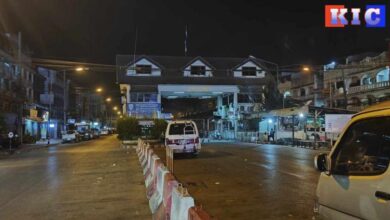Development threatens village life and work

Hsa Keh village is a small fishing community – nothing more than a line of small bamboo houses with leaf roofing. Under a clear sky, three small wooden fishing boats glide onto the beach. A peaceful scene that now has a dark development cloud hanging over the villagers.
Hsa Keh village is in Na Bu Le area, west of Dawei Town in Southern Burma. There is a beach as long as the eye can see. The land down to the beach is flat surround with green mountains rising behind.
On the fringe of Hsa Keh village, signs of the development are appearing – a fixed concrete post has the letters and number KM 0+000 written on it, a Burmese flag flys and new offices and worker camps have been built.
This area is now known as the sea gate – the economic gateway to the Greater Mekong Sub-region or as the Asia Regional Hub to India, Africa, Middle East and Indochina.
Ma Yo Kyi, the wife a fisherman from Hsa Keh village spoke Karen News.
“We earn our living and support our families by fishing, nobody has spoken to us or told us where and when we have to relocate to.”
It is estimated that there are 17 villages and as many as 23,000 people that will have to be relocated to three relocation sites – Bawah, Bagawzun and Pantin-inn – to make way for the mega-project, the Dawei Deep Sea Port and a 204.5 square kilometer industry zone.
Ma Yo Kyi said.
“We don’t want to be relocated, but if we are, we want them to move us to a coastal area where we can still make our living from fishing. We want to continue our work and our way of life. We don’t want to move to the place that is not related to our lives or to where we cannot work. If they move us inland, we cannot live or work.”
The Dawei industry zone will be the largest in South East Asia and it will include heavy, medium and light industry. The industry estate will be house a petrol chemical complex, oil and gas refinery, steel mill and fertilize plant and a coal fire power plant.
The Dawei Deep Sea Port will much larger than the Port of Singapore that is regarded as the world’s busiest port.
The project’s developer, the Thai owned, Italian-Thai Development Company, was recently given support from the Thai government.
The planned area for the industry zone is in Na Bu Le, an area that is the home of the indigenous Tavoyan people, who make their living from rice farming, plantations and fishing.
Villagers said that they have not been told of relocation dates yet, but have heard from unofficial sources that relocation will start before June 2013. Villagers say that they do not want to move or to do so without receiving fair compensation for their land.
U Toe Shwe, from Mu Do village told Karen News.
“I don’t want to move to the Bawah relocation site. They (ITD) have not compensated us for what we asked for our plantation and land.”
U Toe Shwe said he has four and half acres of farmland that supports seven family members.
“When I move I will be forced to leave all my land and my house. I will have difficulties. I cannot rebuild our lives with the small amount of compensation money that I have been offered. In Bawah [relocation site] we will get 80 to 100 square feet of land and for a house. They build three type of houses, type 1, 2 and 3. I will get a type 3 house, which is the smallest. We won’t have land for our agriculture. Our children will not get a house. If they marry or have a family in the future they may not have a house or a place to live.”
The indigenous Tavoyan people worry that by moving out from their native land, their culture, way of life and their people will disappear.
A village monk, U Aung Ba Tha, told Karen News.
“The Na Bu Le area has existed for a long time, since the ancient time of the Burmese monarchy. But now because of the development of the Dawei Deep Sea Port, we have to relocate, we feel unsettled in our minds. It is like moving a big tree and planting it in a new place. You can use water and fertilizer but the tree will fade. Whether it is humans or trees that have to move out from their roots and origins, the result is that they will fade away. We cannot see the issue with the economic eyes which is not the right way. We have to see the problem with a traditional way of life. Their living, their speaking language. They have survived many eras and they still exist as a people today – but that is now threatened.”
U Aung Ba Tha said that the authorities do not understand the indigenous people.
“There are misconception about the people here. Their forefathers chose this area over hundreds of years for good reason – it is the best land for their life and for their new generations.”
U Kyain Myint from Mu Do village told Karen News.
“The name of Na Bu Le will disappear. If the industry is built here Na Bu Le will disappear or not exist.”




